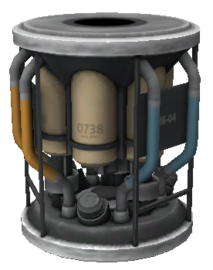Difference between revisions of "Convert-O-Tron 250"
ZeroGravitas (talk | contribs) (→Efficiency: Does now appear to receive engineer efficiency bonus (in 1.2), as with the drills. Most of page's info is outdated too.) |
|||
| Line 20: | Line 20: | ||
The conversion to [[monopropellant]] is significantly less efficient, with a 1:0.8 ratio, making it much more advisable to perform any refining on the surface. | The conversion to [[monopropellant]] is significantly less efficient, with a 1:0.8 ratio, making it much more advisable to perform any refining on the surface. | ||
| − | |||
| − | |||
== Product description == | == Product description == | ||
Revision as of 05:52, 9 January 2017
| Convert-O-Tron 250 | ||
| Converter by Kerbodyne | ||
| Radial size | Large, Radial mounted | |
| Cost | (total) | 8 000.00 |
| Mass | (total) | 4.250 t |
| Drag | 0.2 | |
| Max. Temp. | 2000 K | |
| Impact Tolerance | 7 m/s | |
| Research | | |
| Unlock cost | 24 000 | |
| Since version | 1.0 | |
| Part configuration | ISRU.cfg | |
| Conversion | Liquid fuel + Oxidizer | |
| Inputs | ||
| Ore | 0.5 | |
| Electric charge | 30 ⚡/s | |
| Outputs | ||
| Liquid fuel | 0.45 | |
| Oxidizer | 0.55 | |
| Conversion | Monopropellant | |
| Inputs | ||
| Ore | 0.5 | |
| Electric charge | 30 ⚡/s | |
| Output | ||
| Monopropellant | 1 | |
| Conversion | Liquid fuel | |
| Inputs | ||
| Ore | 0.45 | |
| Electric charge | 30 ⚡/s | |
| Output | ||
| Liquid fuel | 0.9 | |
| Conversion | Oxidizer | |
| Inputs | ||
| Ore | 0.55 | |
| Electric charge | 30 ⚡/s | |
| Output | ||
| Oxidizer | 1.1 | |
| Optimum Temp | 1000 K | |
| Shutdown Temp | 4000 K | |
| Max Cooling | 200 kW | |
The Convert-O-Tron 250 is a converter introduced in version 1.0, and far more efficient than its little cousin, the Convert-O-Tron 125.
Usage
The Convert-O-Tron 250 is a part that converts ore and electricity into liquid fuel, oxidizer, or monopropellant. The former two can be automatically generated in the 9:11 ratio used in chemical engines or produced individually.
Operating the Convert-O-Tron 250 on the surface of a planet or moon requires much less careful planning and allows for more flexible vehicle design. A craft used to shuttle fuel to orbit can potentially burn part of its payload to complete rendezvous or transfer unused fuel reserves as part of the payload, and need only bring the fuel necessary for landing down to the surface. By contrast, an ore carrier must carry fuel for both landing and takeoff to the surface, cannot use its payload as emergency reserves, and needs to have its fuel to payload ratios adjusted to operate in different gravity wells or make rendezvous in different orbits efficiently. On the other hand an ore carrier which also has a Convert-O-Tron 250 is very flexible, as it can both refuel itself and optimally refuel other ships whether they use liquid fuel only or oxidizer as well.
Surface installations can use rovers with docking ports to ferry the fuel between the converter and the landed fuel transport craft. Alternatively, either the transport craft or fuel station can move around on wheels to dock and transfer fuel without an intermediate rover. In place of docking ports, the Advanced Grabbing Unit should be used when available because it is significantly easier to connect. Ore carriers only need to bring drills down to the surface, and can take off directly after their tanks are full.
Alternatively, an asteroid with a docked Convert-O-Tron 250 can also be used as a refueling station, and can be more efficient due to its lack of a gravity well and the ability to maneuver the asteroid into a convenient orbit.
Resource Feed and Priority
Convert-O-Tron units are not subject to crossfeed restrictions in any way whatsoever. A Convert-O-Tron unit can refill tanks on the far side of crossfeed disabled parts even when the difficulty option Resource Transfer Obeys Crossfeed Rules is set. Tanks are filled using the same priority as emptying tanks, tanks with higher priority numbers will be filled first.
Efficiency
The conversion to liquid fuel and oxidizer conserves mass, as ore has twice the weight per unit of its products and produces two units of fuel per unit of ore. It is possible to power the converter by channeling some of the liquid fuel and oxidizer generated into fuel cells, removing the need for solar panels or expensive PB-NUK Radioisotope Thermoelectric Generators, although doing so effectively lowers the mass conversion ratio from 1:1 to 1:0.925 (or lower, if the fuel cell is also being used to power a 'Drill-O-Matic' Mining Excavator), making it more suitable for surface installations, where the conversion ratio is somewhat irrelevant.
The conversion to monopropellant is significantly less efficient, with a 1:0.8 ratio, making it much more advisable to perform any refining on the surface.
Product description
| “ | This mobile processing plant can take raw materials containing even trace amounts of oxygen and hydrogen, and crack them into useful fuel products. When operated by a skilled engineer, you will be able to operate with better efficiency. These modules operate best at their ideal operating temperatures, and features auto-shutdown in the event of excessive overheating. Radiators can be used to help manage excessive heat. — Kerbodyne |
” |
Changes
- Auto shutdown, new description added, new name
- Initial release
